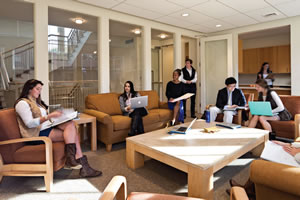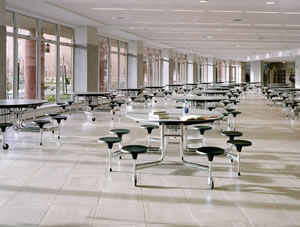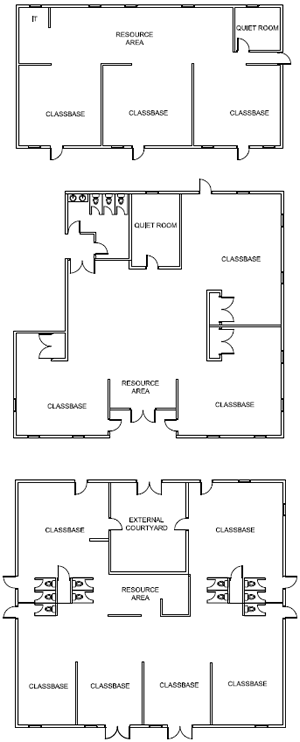Do Classrooms Have To Be Designed A Certain Way?

PHOTO BY ROBERT BENSON
Have teaching and learning styles evolved enough that we should change the physical space?
These are not simple questions to answer. The current pedagogy, along with school designers, encourages a more progressive flexible learning setting. The flexibility of the learning spaces ranges from providing moveable furniture all the way to operable wall partitions. Beyond the traditional lecture-style classroom setting where the educator speaks from the front of the classroom, students are now encouraged in more variable physical and learning settings including more informal child-centered approaches such as group discussions, movement learning, and learning from technology.
As much as we want to completely break down the classroom barriers from both a physical and social perspective, there are some concerns to think about before designing your next new school building. In the 21st century, we call them “flexible learning environments.” Back in the ‘60s and the ‘70s, a similar trend was happening in the educational world — they were called the “open-plan classrooms.” There was also another brief revival during the ‘90s. Sounds familiar? So why did the trend not stay around the last time?
We know that you are going to say, this time it’s different — but how different is it? What have studies from the past, as well as current research, taught us about these flexible learning environments?

PHOTO BY SMMAP
Lesson #1 - More students = more noise
There is plenty of research confirming that children, in particular younger age groups, do not learn as well when the background sound levels are high. This does not only include noise produced by the air ventilation system, but also noise from the rest of the environment. Plenty of studies, including the most recent one published by Airport Cooperative Research Program in 2014, confirm that aircraft and road noise impacts reading comprehension and learning motivation. There are also plenty of studies on the adverse effects of noise on children’s cognition.
While we are not talking about the effects of aircraft noise here, even noise produced by students within the same learning space and adjacent spaces can make a huge difference on learning. This is especially true in cases where the learning space is semi-open or completely open with multiple learning “classbases.” All the intrusive noise from the adjacent classbases can further increase the ambient sound levels.
Surveys conducted in the UK by B. Shield et al., indicate that ambient levels are lowest in a lecture-style setting and highest in movement-based learning. Unfortunately, it’s the younger students that tend to be in a movement-based learning environment and they actually need the lower background sound levels, as their cognition levels are still in the development phase.
There is an interesting study by the Boys Town National Research Hospital in Omaha, where the researchers simulated a virtual classroom to test language comprehension for both adults and children. What they found is that children performed more poorly than adults in both the group discussion and lecture conditions. Unlike adults, children also performed more poorly in the discussion condition, compared to the lecture condition. Another test within the study was variability in the acoustical conditions of the learning space. The researchers found that comprehension improves with better acoustical conditions, regardless of the learning styles.
Lesson #2 - Learn from the users
Surveys, when done with sufficient data, provide extremely useful evaluation of school designs. The most revealing survey, conducted by L. Baker at the Center of Built Environment at UC Berkeley, was highly critical of the open-plan school design. Baker conducted Post-Occupancy Evaluation (POE) Surveys in 61 schools buildings with roughly 1,700 teachers across the country. Along with surveys confirming that windowless learning environments are the least satisfactory to the teachers, Baker also found that open plan classroom schools ranked the lowest in satisfactory level among 60 different schools across America.
Center of Built Environment, UC Berkeley
However, not all evaluations of open-plan teaching environments are negative. While the researchers agreed with many of the previous studies above, E. Greenland and B. Shield at London South Bank University took measurements at 42 semi-open learning spaces and was able use their data to develop guidance to make the flexiblespaces work acoustically. In their study, they focused on the semiopen learning spaces rather than a fully open learning space. In the semi-open condition, there would be multiple classbases separated by some physical barriers (shown in Figure 1 with a few different examples). These classbases would share common areas, most often referred to as resource areas. Another important component in the common area is the quiet room, which is a fully enclosed space to provide more speech privacy when this is needed.

Figure 1. Semi-open plan design layouts suggested by Greenland & Shield
How we can make it better
In support of the current trend in pedagogy, here is what we recommend based on our experience and research:
1. The more students you have in one space, the more noise there will be. Greenland et al. suggested that each semi-open plan unit should have no more than three learning classbases. The classbase openings should always connect to a shared common area rather than directly to another classroom. Too many adjacent classbases means more noise intrusions that the teachers cannot control.
2. Can you hear me now? The students sitting farthest from the teacher (and typically closest to the room opening) will have the hardest time hearing the teacher/other students. For critical listening activities when adjacent activities are not coordinated, students should be gathered close around the teacher, away from the opening of the classbase.
3. Coordination between teachers. Learning activities involving movement, in particular with different technology/work stations, should be coordinated between the classbases in a unit. Otherwise the students seated closest to the opening will be distracted by the intrusive noise next door. How is the teacher in one classbase going to make the students do the math problems when they can go next door and have fun with the other students?
4. Design an acoustically dry learning space. Reverberation time of the entire learning unit should not exceed 0.4 seconds for students to hear well in a busier and noisier learning environment. This is lower than the requirement of 0.6 seconds established by ANSI-S12.60 (Classroom Acoustics Standard) for typical classrooms with normal hearing students. The purpose of such a low reverberation time is to reduce the transmission of student-generated noise. The most effective solution is to provide a highly sound-absorptive ceiling and acoustical wall panels. Carpet does not absorb sound, but it will help reduce footfall and chair-movement noise.
5. Just because they can’t see you, doesn’t mean they can’t hear you. Consider designing the semi-open classbases with the option to be fully enclosed when the teacher finds it necessary. This can be accomplished by installing operable partitions at the opening of each classbase and having full-height stud walls for the demising walls. The type of walls and operable partitions separating the learning spaces should achieve appropriate Sound Transmission Class (STC) ratings as addressed in the ANSI-S12.60, especially for buildings that are designed to meet LEED for Schools or CHPS.
6. The HVAC system should be quiet. Why let additional intruding noise sources get in the way of education? With careful space planning and good designs early on, most HVAC noise can be avoided.
7. Don’t risk it for special education. Special-needs education students need quieter and physically separated spaces more than the average students. If you know your school has a high percentage of special-needs students, consider a more traditional fully enclosed classroom design layout.
This article originally appeared in the issue of .